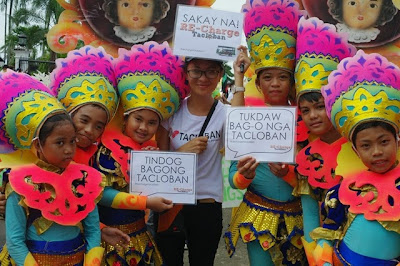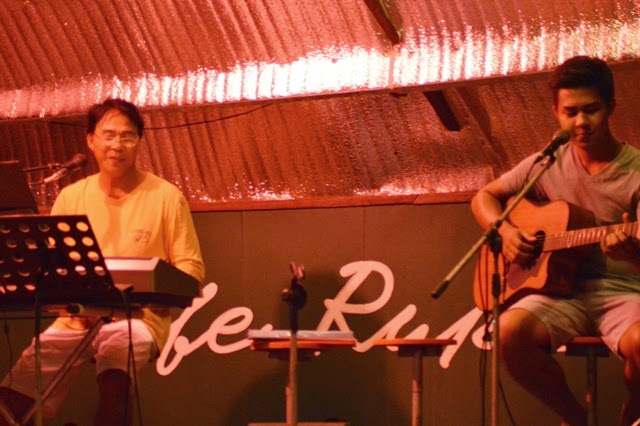Communities’ lack of information on how to use the solar panels
 |
| Zeny Margallo, a resident of Cabalawan transitional shelters placed her solar panel attached to their wall which place was not hit by the rays of the sun. (photo by: lottie salarda) |
I was invited (for the second time) by the Climate Change Commission to attend the seminar-workshop on understanding Climate Change and on how to write stories involving the said complex issue.
I’ve listened very well on every speaker and learned very important concepts from the experts. They said the terms were very hard to digest in one sitting. Yes, that’s true. It’s been my second time to attend the workshop, but it seems all things were new to me.
We spent the second day of our workshop by visiting the transitional shelters in Brgy Cabalawan and in the permanent shelters in the relocation sites. We were instructed to interview the residents. We had asked if what comes to their minds if they heard the word climate change or what their understandings of it are.
I encountered similar answers from two residents who were living adjacent to each other. Formerly, they lived in Brgy 88 San Jose Tacloban City when typhoon Yolanda ruined their houses and even their lives.
Their answers were alarming as they don’t even know what it is.
“Hindi ko alam kung anu yan,” said Amalia Mista, 54. When I told them the effects of CC, they’d just nod in affirmation.
 |
| A solar powered lamp was put at the doorstep of a house. |
Families living in the permanent shelters have no electricity. They brought the solar powered lamp donated by IOM to them when they were still living in shanties.
I remember the time when we, together with Prune and Mathieu iCSC’s French interns went to Brgy 88 and 89 to offer our free services in repairing the more than one-year-old solar powered lantern.
We noticed that some of the lanterns were not functioning at all as we see the rusts in the wires inside that cause its malfunction.
We learned that the fisherman used it as their source of light in fishing at night and that it had been exposed to sea water. It wasn’t able to lasts because of the absence of information on how to maintain the use of the solar lanterns.
Like Mista, her neighbors also do not know what is CC and what are its effects on human lives and what are their role in mitigation of its effects.
It’s sad that all they want to do is work and earn for their daily food. Many of their husbands who were fishermen weren’t able to get their livelihood back because of the distance from their new home.
Mista and her family use an old solar lantern as their source of light during the night. But as I have observed, this lanterns were not properly placed under the heat of the sun. It was just keep in a place where the rays of the sun are not shown.
We then immediately transferred to the transitional shelters where we found a different community. The image that strikes me is the picture where a 150 watts solar panel was attached to the wall of a house owned by Zeni Margallo.
I also noticed a small round solar panel hanging near their door. I took steps closer to the house where Margallo was sitting at their stairway. To my surprise with the position of the panel, I asked Margallo about on the usage of the panel. Each household was not allowed to have electricity connection because their stay is temporary in nature.
Because of this, Margallo’s family was forced to acquire a solar panel for their light bulb. I asked her why she placed the panel attached to their wall where the rays of the sun cannot penetrate into the cells of the panels.
“Ah, kasi baka mabasa ng ulan masira lang siya. Ilaw lang ang gamit naming dyan, bukod diyan hindi na naming alam kung anu pa ang pwedeng gamit ng solar panel,” Margallo said.
She had just learned the usage of the solar panels immediately after typhoon Yolanda. But she didn’t even know on how it is maintained and how is the proper way of using it.
“Gaano katagal magagamit ang solar panel na ito?” she asked me. I told her that with the proper maintenance and usage as long as the panel is not broken, it would probably last for more than 10 years. Her face showed amazement on what I have told her.
She had decided to bring the panel wherever they will be transferred.
Ruby Figeuroa, the President of Cabalawan Transitional shelters association nods in agreement to strengthen the information on how to use the solar panels especially for those vulnerable sectors like them.
“Napaka-importante ng solar power sa amin lalo na wala kaming kuryente sa bawat bahay. Mahalagang malaman ng mga tao kung paano ito gamitin at paano alagaan,” said Figueroa.
I noticed the absence of information in using renewable energy. She doesn’t even know that what she is doing is a contribution in the mitigation of climate change.
In this experience, I noticed that the issue on climate change has not yet been introduced to grassroots communities which are vulnerable to experience such great effects.
The government should not only focus on relief operations, rehabilitations, giving housing or extending assistance to the victims, they should also give importance in giving the right information and understanding on what is happening in our changing climate.
Their programs on mitigation and adaptation should be sustained by intensifying their campaign. And of course, if the government is sincere in pushing or supporting clean energy like the use of solar, they must intensify their information dissemination about the usage of such sustainable energy.
But so far I’ve seen none. No efforts were done. Good thing that there are non-governmental organizations who leads for the introduction of RE as an alternative source of energy here in Tacloban City.



Comments
Post a Comment